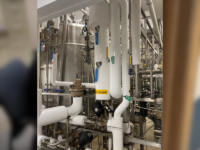Metropolitan Utilities District (MUD) is a customer-owned public utility. MUD provides natural gas and water services to metropolitan Omaha area. Similar to utilities across the country, MUD is tasked with the challenge of addressing aging infrastructure for sustainability in serving the needs of its community.
MUD owns and operates three water treatment facilities capable of supplying potable water in excess of 300 million gallons per day (MGD) to provide high-quality safe drinking water to its 208,256 customers. MUDs 158 MGD Florence Water Treatment Plant (WTP) is the largest and oldest of MUD’s three treatment plants, providing about half of the water system’s overall capacity. The plant draws its water supply from the Missouri River.
The Florence WTP needed to replace and upgrade old equipment to improve the plant’s reliability, extend its operating life and meet stricter water quality regulations. When updating a 125-year-old water facility, it’s a high-risk, high-stakes undertaking. To accomplish the task at hand, the district undertook two major improvement projects. First, upgrading the SCADA and control system, and overlapping that project, the second project involved upgrading the existing filtration building.
The challenging part of this type of complete upgrade is many contractors from different trades working in a small area at once. The Florence WTP needed to remain up and running, with no complete shutdown period which would have allowed for ease of installation. With two projects going on simultaneously in the same building, there had to be meticulous planning involved.
Working as the system integrator subcontractor to both projects’ general contractors, Huffman Engineering knew what had to be done to help pull off these two critical projects and meet the tight time frame allotted. Huffman Engineering has completed many projects for MUD, and has been regarded as a preferred vendor and reliable resource for nearly two decades. Huffman Engineering’s team has intimate knowledge of MUDs equipment, processes and regulatory requirements. In fact, the team had installed the current controls and SCADA system in the late 1990s.
In 2011, the district established a district-wide standard for its control and Supervisory Control and Data Acquisition (SCADA) Systems to capitalize on the benefits of advanced automation technology. The new standardized technology leverages the use of data more effectively with automated processes and reports, improved cyber security, improved patching, antivirus updating and authentication. Prior to establishing a standard, MUD had different SCADA Systems at each facility.
The system integration plan for success required careful planning, meticulous attention to detail, and excellent communication and coordination with MUD and the other contractors involved.
Over an 8-week time period prior to the 3-week filtration plant shutdown, 6 PLC control panels were replaced and 3 previously installed PLC panels were updated to the new standard. The plant was kept running under manual control while swapping out the PLCs. During the planned shutdown, 5 PLC control panels were replaced at the filtration plant.
SCADA and HMI upgrades required upgrading to a newer version of the software, and implementing MUD’s new standards. The new SCADA System and HMI standard uses a greyscale color scheme, keeping colors to a minimum unless there needs to be action taken by the operator. This color strategy reduces operator fatigue.
In addition, Huffman Engineering developed the software for the HMIs to be installed in the filter plant, independent of the SCADA system. This allows MUD’s operators to view what’s going on in the filter plant while at the facility. Huffman Engineering also added a backup feature to allow for independent control of the filter beds should the SCADA system go down.
Through team dedication and unyielding commitment to their customer’s success, Huffman Engineering succeeded in meeting the tight timeline, keeping everything on the old system going while moving up to the new system.
Highlights of the Path to Success
Consistent project methodology provides structure for high-quality deliverables. Huffman Engineering’s project methodology of careful planning before, consistent monitoring during, and quality check-up after projects assures both high value and high quality for customers.
The following are highlights of Huffman Engineering’s preplanning actions and onsite strategy to avoid installation problems and successfully meet MUD’s aggressive schedule:
- Detailed Panel Drawings – Some of the original panels didn’t have drawings, or had very poor drawings. Huffman Engineering’s team went in and verified all the wiring that goes out to the field from the panels being replaced and labeled everything so when one panel was removed, the detailed drawings made it easy for seamless installation by the electrical contractor.
- Communication and Coordination with Other Contractors – Huffman took ownership of communicating and coordinating schedules with all parties involved to keep the plant up and running. For example, part of the project involved putting in a fiber optic ring around a plant, which allows for communication to travel in either direction to avoid a complete shutdown due to one device failure. Huffman Engineering planned which PLC panels to do first based on how the communication ring was being put in. This was important to keep the plant running and not lose communications going both directions.
- Extra Measures Matter – During the whole process, Huffman Engineering coordinated communication to two different servers at the same time as an extra precaution to avoid a shutdown.
- Attention to Detail When Converting Code – For the PLC programming portion, Huffman Engineering had to convert the old code from the old software to the new. The program had to be completely re-written and then brought up to the new MUD standard.
- Going the Extra Mile – To minimize onsite changes and potential delays, prior to onsite installation, Huffman Engineering performed an HMI checkout by simulating every PLC on an in-house computer and connecting it to a factory test version of the HMI software. Going through and checking every point in the new PLC before going onsite and installing it to make sure everything would work and to minimize on-site changes.
- When Critical, Have a Backup Plan – in one particularly sensitive case, a temporary panel was built to keep control of some of the valves operating during a transition period. The temporary panel was removed once the new panel was up online.
- Standard Tags and Naming Conventions Provide Clarity – Another programming task required of Huffman was to standardize tag and naming for the HMIs. Each different zone in the plant was given its own prefix for the tag name. This makes it easy for operators to identify which PLC they’re dealing with as soon as they see a certain tag name.
- Providing Access to Historical Data – Huffman Engineering was also responsible for installing a historian. The historian provides critical analysis and reporting capabilities allowing MUD to leverage large volumes of plant data across its operations in both real and historical time view for meaningful decision making and EPA compliance reporting.
- Improving Security – The final component was to use a new hardware system. Before, the plant had two tower computers. They weren’t even servers; they were just regular work stations. Huffman Engineering moved the HMI servers to where they have server racks isolated in a locked secure room. Therefore, only the client machines that the operators need to use are in the main control room.
The MUD project proves it is possible to do a major renovation in a plant without having to completely shut it down – if everything is planned and coordinated. Bottom-line, a well-planned and coordinated project preserves revenue and assures uninterrupted service to customers.




